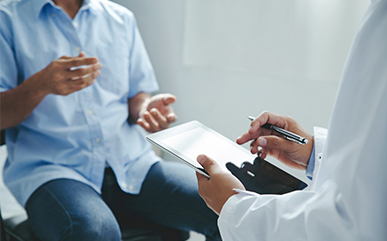Actigraphy advances a patient-first approach: Reduce patient burden — and make the most of valuable data
In a patient-centric clinical trial, we focus first on patient needs, finding ways to make participation simpler, more comfortable, and less invasive.
To lessen patient burden, we need protocols that accommodate participants’ schedules, locations, and preferences — and wearable technology can play a role in that effort. Wearables such as actigraphy devices let us measure quality of life while making data collection much easier for the patient.
Through accelerometers and optical sensors, actigraphy monitors track a user’s activity, heart rate, mobility, and sleep patterns during the course of a normal day. With continuous data collection, we see a broader view of a patient’s health, extending our knowledge far beyond what we capture during visits to site clinics. This gives study teams, sponsors, and CROs access to valuable insights not available through other avenues.
Thanks to actigraphy’s precision, we can detect even subtle shifts in patient behavior. Did participants become more active as the trial progressed? Sustain activity for longer periods? Were they sleeping longer? More deeply? By pairing actigraphy measurements with patient-reported outcomes (ePROs) and lab samples, sponsors can see the wider impact of a treatment, such as reductions in side effects or improved activity levels. Actigraphy-specific data allows sponsors to learn more deeply from their patient populations. Those findings can inform future drug development and research.
A recent survey of pharmaceutical companies found that 52 percent of respondents have used activity trackers in clinical trials. And 65 percent plan to use them in the future.i As these sponsors know, actigraphy data can be incredibly beneficial. But to fully capitalize on the technology, you need a detailed plan for how you’ll use it.
Choose the device that’s best for your trial
Actigraphy feels familiar to researchers and patients alike because of the many activity trackers available commercially, such as Apple watches and Fitbit bands. If you want to harness the power of actigraphy in a clinical trial, however, we always recommend using medical-grade devices.
While commercial devices may be easier or less expensive to source, they don’t meet the demands of clinical research. Instead of raw data, these devices provide step counts and sleep durations filtered through proprietary algorithms. This makes results less precise and less transparent, which will impact a regulatory authority’s confidence in your submission.
And while manufacturers support medical-grade devices for multi-year trials, commercial devices have shorter lifecycles. A medical-grade device might use the same firmware for a decade to assure consistency in data collection. In the same timeframe, a commercial device may have introduced (and discontinued) several versions, so if patients join a study on a rolling basis, they might use different tracker models employing different data algorithms.
Determine your purpose
Actigraphy devices generate enormous amounts of data, none of which are human-readable. To maximize its value, you need to know exactly what you want to learn from it. Your plans for analysis will impact how your data is collected, reported, and delivered, with the device manufacturer customizing the platform for your purposes.
Every protocol should clearly define how actigraphy will support study endpoints. Specificity is critical, so this is the time to decide which measurements you’ll compare to actigraphy outputs. For example, one home-based studyii asked participants with arthritis to perform a sitting-to-standing test three times a week for four weeks. Participants were fitted with activity monitors and completed ePRO questionnaires after each test. By correlating ePROs to actigraphy data, researchers found that the time required to complete each test was significantly associated to the intensity of pain and stiffness reported by patients.
If you have questions about data and what they can do for you, consider enlisting a partner to help. A CRO offers access to additional expertise — statisticians, data management specialists, and others who can guide you through types of datasets and standards for reviewing them.
Consider the regulatory environment
While determining your purposes for data, you’ll also want to keep the evolving regulatory landscape in mind.
Because of the relative newness of the technology, regulatory agencies are still forming opinions on actigraphy in clinical research. Currently, several authorities have issued guidance but we’re waiting for formal regulations.
We’re excited about the ways actigraphy could support primary endpoints but we’re not there yet. Based on available guidance, we recommend sponsors use actigraphy for secondary or exploratory endpoints. And our regulatory experts can advise sponsors from trial design forward, helping ensure that your data conforms to all available guidance.
Beyond its value in supporting endpoints, actigraphy data included in submissions will also compel regulatory agencies to issue broader regulations. If we want to fully use this valuable tool in clinical research, we can nudge regulators forward by submitting actigraphy-informed results and obliging regulators to rule on it. High-quality submissions will help demonstrate the reliability and usefulness of actigraphy.
An example of this is the European research project PROActiveiii, in which a range of partners (including seven biopharma companies) developed tools to capture physical activity data in patients with COPD. Fitted with medical-grade actigraphy devices, all participants self-reported their experiences with physical activity and some received interventional coaching. Actigraphy data showed a meaningful increase in step counts for coached patients.
After submission, the European Medicines Agency (EMA) issued a qualification opinion regarding the use of PROactive tools in clinical trials. In addition to clarifying how the PROactive tools can be used in the future, this opinion expands the regulatory landscape and paves the way for future use of actigraphy in clinical research.
Bolster patient compliance
In order to deliver meaningful data, actigraphy devices must be worn continually. In the past, device designers have been primarily concerned with their scientific function, meaning comfort hasn’t been a top priority. That’s changing, however, and devices are becoming less noticeable, more comfortable, and more intuitive to use. We test and validate a range of devices — and comfort is always something we consider — so our sensors team can point you to the sensors that will be most acceptable to your patient population.
A CRO partner can also create and carry out a plan to encourage compliance. At Parexel, we regularly monitor compliance to identify and address adherence issues. Our wrap-around services reduce the burden on patients and sites while also guarding the integrity of data collection.
The future of actigraphy
During a clinical trial, investigation sites collect critical data. But data are only one window into a patient’s well-being. Going forward, we expect to see actigraphy devices used more often in clinical trials and paired with other sensors: devices that measure heart rate, blood pressure, temperature, or blood glucose levels, for example. Collecting these data remotely will reduce the frequency of patient visits to clinics. will also give sponsors and care teams a fuller picture of a patient’s quality of life — insights researchers are eager for.
We also expect to see actigraphy expand into more therapeutic areas. Bulky actigraphy devices might not work for patients with dermatitis or cancer, for example. But as device forms improve and monitors become easier to wear, they will work for a wider range of patient groups.
A survey recently found that half of sponsors who use wearable devices in clinical trials introduced them in 2019 or later. And of those not currently employing wearables, more than 80 percent expect to begin using them within two years.iv As technology continues to improve — and acceptance increases — we know actigraphy meters and other sensors will become increasingly important to clinical trials, including yours.
Ready to move forward with actigraphy or take its use further? Create a plan that considers all the angles: device selection, data use, regulation, adherence. And enlist experts when you need to. With the right approach and the right team, you can remove patient barriers and maximize actigraphy’s value.
Related Insights
Blog
Highlights from ISMPP Asia Pacific Meeting 2021
Sep 20, 2021
Whitepaper
Optimizing Biosensor-based Trials
Feb 1, 2023
Webinar
Unlocking Success in Obesity Clinical Trials: Mastering Patient Engagement and Retention
May 15, 2025
Video
Part 2: Risk-based Quality Management Video (RBQM) Series
Nov 11, 2021
Blog
Taking a Proactive Approach to Post-Launch Patient Accessibility in Strategic Planning
Aug 4, 2022
Video
A Life in a Day
Jul 28, 2022
Blog
Digital Biomarkers – The Future of Precision Medicine
Jul 21, 2022
Video
Parexel Site Alliances
Jul 13, 2022
Video
Nurse Advisory Panel
Jul 13, 2022
Blog
Parexel names first Patient Ambassador
Jun 17, 2022
Podcast
RBQM Podcast Series | Episode 3: Staying within the Guardrails: How to Push the Boundaries in a Highly Regulated Industry
Jun 16, 2022
Blog
Patient Advocacy Groups: A vital partner for sponsors that understand how to engage with patients
May 3, 2022
Related Insights
Blog
Highlights from ISMPP Asia Pacific Meeting 2021
Sep 20, 2021
Whitepaper
Optimizing Biosensor-based Trials
Feb 1, 2023
Webinar
Unlocking Success in Obesity Clinical Trials: Mastering Patient Engagement and Retention
May 15, 2025
Video
Part 2: Risk-based Quality Management Video (RBQM) Series
Nov 11, 2021
Blog
Taking a Proactive Approach to Post-Launch Patient Accessibility in Strategic Planning
Aug 4, 2022
Video
A Life in a Day
Jul 28, 2022
Blog
Digital Biomarkers – The Future of Precision Medicine
Jul 21, 2022
Video
Parexel Site Alliances
Jul 13, 2022
Video
Nurse Advisory Panel
Jul 13, 2022
Blog
Parexel names first Patient Ambassador
Jun 17, 2022
Podcast
RBQM Podcast Series | Episode 3: Staying within the Guardrails: How to Push the Boundaries in a Highly Regulated Industry
Jun 16, 2022
Blog
Patient Advocacy Groups: A vital partner for sponsors that understand how to engage with patients
May 3, 2022





